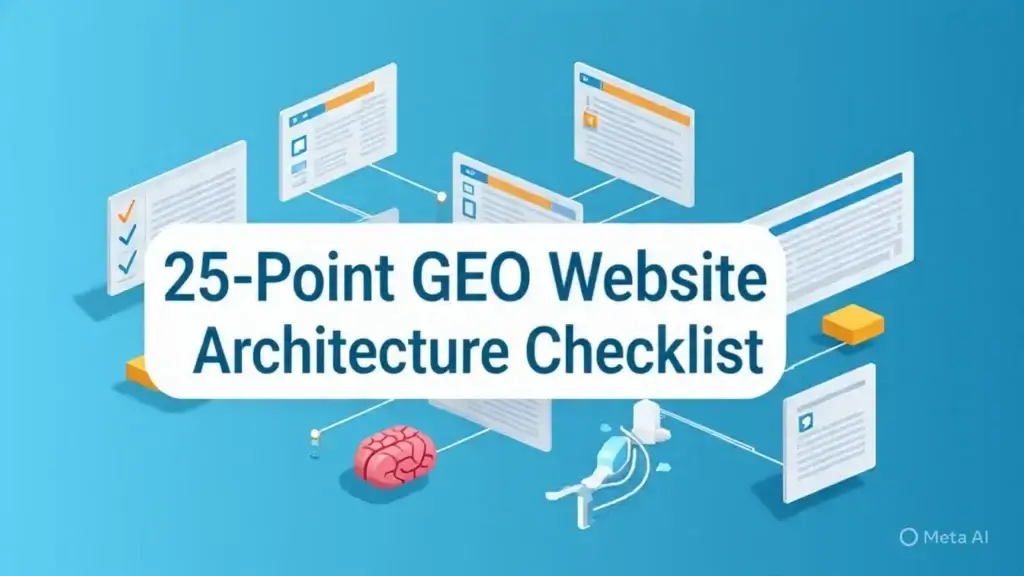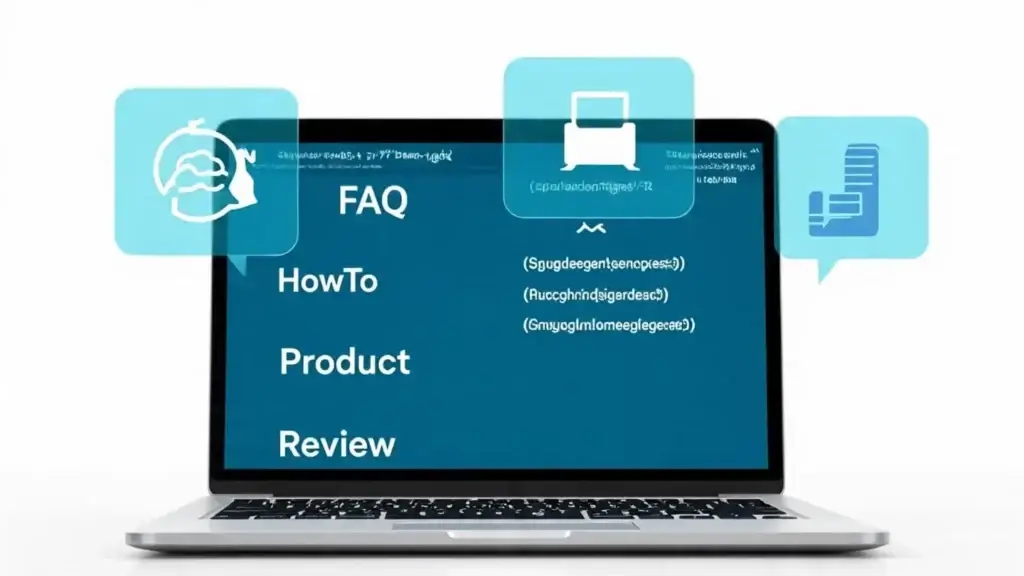TL;DR: This post gives you a practical, prioritized
GEO audit checklist for e-commerce (50 tests) that focuses on
product pages, images, structured data, review signals, and a fast remediation sprint you can run this week. Use the checklist to make product pages
extractable, cite-worthy, and
AI-friendly for ChatGPT, Gemini, Perplexity, and other generative discovery channels.
Why E-commerce need a GEO audit?
AI discovery (generative search) doesn’t list links — it
pulls answers from sources it can parse and trust. That makes product pages vulnerable to being invisible even if they rank well in traditional search. A
GEO audit checks whether your product pages are
machine-readable, authoritative, and extractable so generative engines can cite them. Start with technical crawlability, then product-level structure (short answers, specs, schema), and finally review/retail signals.
What you’ll get in this post
-
-
- A 50-point GEO audit checklist specifically tuned to e-commerce product pages.
- A prioritization matrix + 2-week remediation sprint you can run now.
- Micro-insights, warnings, and a downloadable lead magnet idea: E-commerce GEO Audit Google Sheet (50 points) + remediation sprints.
How to use this GEO audit checklist
- Pick the top 10 revenue product pages → run quick checks (1–12 below).
-
-
- Mark each test Pass / Fail / Partial in a sheet.
- Prioritize quick wins (low effort, high impact). Implement across 2 weeks.
- Track citations/mentions with visibility tools and prompt testing.
Site & homepage (site-level GEO audit checklist)
- llms.txt / policy check — do you allow LLM bots or explicitly block them? (Experiment cautiously).
- robots.txt & GPTBot access — confirm AI crawlers aren’t accidentally blocked.
- HTTPS + canonicalization — canonical headers present, no conflicting canonical URLs.
- Sitemap includes product feed(s) (XML + merchant feed).
- Organization schema (logo, sameAs, contact) present on the site root.
- Clear short brand summary on homepage (1–2 sentences extractable for AI).
- FAQ hub or sitewide Qs — centralized, schema-marked FAQ pages.
- Core Web Vitals & mobile readiness — especially CLS and LCP for product images.
(Why these matter: site signals and access determine whether LLMs can even see your content.)
Homepage & category checks (category-level GEO audit checklist)
-
-
- Category pages include a 50–80-word “what this category is for”—AI-friendly summary.
- Category H1 + short answer in the first 100 words.
- Breadcrumb schema and pagination markup on category lists.
- Category page uses structured product lists (schema or microdata) for top SKUs.
- Internal linking from category → top product pages (anchor text = intent phrasing).
- Category metadata (meta description + OG) that matches buyer intent.
- Canonical + parameter handling for filter pages.
Product page checklist (short answer summary, specs, structured data, images)
Product pages are where the sale happens — make them extractable:
- Short answer summary (50–70 words) at the top: what it is, who it’s for, one key spec — AI can quote this directly.
- Unique, human product description — not just manufacturer copy; add micro-use cases.
- HTML spec table (consistent rows: weight, dims, color, materials). Tables are highly extractable.
- Product JSON-LD (Product + Offers) is present and valid.
- Price + availability in schema (offers, priceCurrency).
- SKU + GTIN + MPN fields filled (search engines & retail feeds use them).
- Short FAQ (3–7 Qs) per product using FAQ schema.
- Shipping & returns snippet — short, clear, and machine-readable.
- Comparison bullets (vs similar models) in a uniform format — easy to extract.
- “Best for” one-line to aid intent matching (e.g., “Best for budget home cooks”).
- Stock/availability structured signal (InStock, PreOrder).
- User Q&A schema if you host product Q&A.
- Prominent CTA and conversion signals (so AI can infer commercial intent).
- Concise, summarizable paragraph near the top for snippet extraction.
- Variant & attribute clarity (color, size) in markup and HTML so LLMs parse variants.
Visual & attribute data (images & media)
- Alt text including attribute + SKU (e.g., “Men’s blue running shoe – SKU 9876”).
- Image captions with spec highlights for the main hero image.
- Image file names include product slug or SKU (avoid random names).
- Responsive images (srcset) + WEBP + CDN for performance.
- Image structured data (ImageObject) inside JSON-LD for key images.
- All images are indexable & not blocked by lazy-load misconfig (render and test).
Structured data & metadata checklist
- JSON-LD approach for Article/Product/FAQ/Breadcrumb/Organization. (Prefer JSON-LD over microdata).
- AggregateRating + reviewCount populated when available.
- FAQ schema for product Qs (3–7 short Q/A pairs).
- BreadcrumbList schema matching visible breadcrumbs.
- Organization + sameAs links to major profiles.
- Offer valid until for promotions to avoid stale price pull issues.
- Variant structure (isVariantOf) is properly modeled for SKUs.
Retail-media & reviews signals
- Review diversity: mix of site reviews + third-party (Google, Trustpilot).
- Verified buyer flag or markups in reviews where possible.
- Review schema passes Rich Results test (use Google/Schema validators).
- Retail feed parity: product feed (Google Merchant/Shopify/Marketplace) matches site: price, availability, GTIN.
Tech, crawlability & detection tests
- GPTBot / relevant LLM user-agent crawl test — simulate or check logs.
- Page speed (LCP, FID/INP, CLS) — images and JS-heavy pages penalize extraction.
- Server headers & rendering: structured data appears after JS render? Use server-side JSON-LD or prerender where needed.
Prioritization matrix + 2-week remediation sprint (step-by-step)
Prioritize: top 10 product pages by revenue/traffic.
Sprint Week 1 (Quick wins):
-
-
- Day 1: Add a 50–70-word short answer to the top 10 pages (items 16 & 29).
- Day 2–3: Add HTML spec tables (18) + consistent SKU/GTIN fields (21).
- Day 4–5: Add JSON-LD Product + Offers + FAQ schema for those 10 pages (19, 22, 37).
Sprint Week 2 (Medium wins):
-
-
- Week: Update image alt/file names + implement srcset (31–35).
- Finish: Ensure feeds match (47), run Rich Results test (46), and set tracking.
Measure: Use prompt tests and visibility tools (Nozzle / SearchEye / GenRank) to detect early mentions or paraphrases; track on a weekly cadence.
Micro-insights & warnings
-
-
- Micro-insight: A 50–70 word summary written as an answer to the explicit buyer question (“What is X and who should buy it?”) is often enough for LLMs to quote.
- Warning: llms.txt is experimental — use it only if you understand tradeoffs; some providers treat it inconsistently.
- Micro-insight: Tables and bullet lists are more likely to be paraphrased or copied into answers than long prose. Use them for specs.
- Warning: Don’t duplicate manufacturer specs blindly—add short, actionable use cases and UGC to increase citation value.
Example JSON-LD snippet (product + offers + FAQ) — paste into head
{
“@context”:”https://schema.org”,
“@type”:”Product”,
“name”:”Acme Running Shoe — Model X”,
“sku”:”ACX-2025″,
“gtin13″:”0123456789012”,
“image”:[“https://cdn.example.com/acx-hero.webp”],
“description”:”A lightweight running shoe best for daily jogs — breathable mesh, 8mm drop.”,
“offers”:{
“@type”:”Offer”,
“price”:”79.99″,
“priceCurrency”:”USD”,
“availability”:”https://schema.org/InStock”,
“url”:”https://example.com/product/acx”
},
“aggregateRating”:{
“@type”:”AggregateRating”,
“ratingValue”:”4.5″,
“reviewCount”:”123″
}
}
FAQs
- What is a GEO audit checklist?
A systemized list of checks that make content machine-readable and cite-worthy for generative engines.
- Will GEO optimization hurt SEO?
No — most GEO best practices (structure, schema, clarity) help both humans and search engines.
- How often should I run a GEO audit?
Every 3–6 months or after major model/search UX updates.
- Do I need llms.txt?
It’s experimental. Only use it if you understand provider adoption and risk.
- Which pages should I prioritize?
Top revenue/product pages, high-traffic category pages, and pages that already rank in snippets.
- Does product schema make ChatGPT cite my pages?
Schema makes content easier to parse — it increases chances but doesn’t guarantee citation. Track with prompt tests and tools.
- How do I know if AI is using my content?
Use prompt testing and monitoring tools (Nozzle, SearchEye, GenRank) to detect paraphrases/mentions.
- What quick wins produce the fastest results?
Add a short answer (50–70 words), spec table, and JSON-LD to your top product pages first.
Conclusion — next steps (concise)



